The Trial
[Roger Waters]Good morning, Worm your honor.
The crown will plainly show
The prisoner who now stands before you
Was caught red-handed showing feelings
Showing feelings of an almost human nature.
This will not do.
Call the schoolmaster!
I always said he'd come to no good
In the end your honor.
If they'd let me have my way I could have
Flayed him into shape.
But my hands were tied,
The bleeding hearts and artists
Let him get away with murder.
Let me hammer him today.
Crazy...toys in the attic I am crazy,
Truly gone fishing.
They must have taken my marbles away.
[Choir]
Crazy, toys in the attic. He is crazy.
[Roger Waters]
You little shit you're in it now,
I hope they throw away the key.
You should have talked to me more often
Than you did, but no!
You had to go your own way. Have you broken any homes up lately?
Just five minutes, Worm your honor,
Him and Me, alone.
Baaaabe!
Come to mother baby, let me hold you in my arms.
M'Lord I never wanted him to get in any trouble.
Why'd he ever have to leave me?
Worm, your honor, let me take him home.
Crazy, over the rainbow, I am crazy,
Bars in the window.
There must have been a door there in the wall
When I came in.
[Choir]
Crazy, over the rainbow, he is crazy.
[Roger Waters]
The evidence before the court is incontrovertible
There's no need for the jury to retire.
In all my years of judging I have never heard before
Of someone more deserving of the full penalty of law.
The way you made them suffer,
Your exquisite wife and mother,
Fills me with the urge to defecate!
Since, my friend, you have revealed your deepest fear
I sentence you to be exposed before your peers.
Tear down the wall!
[Crowd Chant]
Tear down the wall!
Song In A Sentence:
Pink puts himself on trial – conducted by the exaggerated and personified bricks – and ultimately orders his wall be torn down when he judges himself both responsible for the making of the wall as well as capable of reconnecting with the outside world.

I n my original Wall analysis penned in 1997, I remarked that not enough could be said about “the Trial.” Years later and I still stand by that sentiment. “The Trial” acts as both the musical and narrative climax, yet even that word and all its implications of resolution doesn’t quite do the song justice. In many ways, “the Trial” epitomizes all that is the Wall, combining the album’s high theatrics, unflinching cynicism, dark humor, tongue-in-cheek irony, deep emotion, and (paradoxically) both unwavering nihilism and steadfast optimism. The song is a seeming contradiction, offering a dichotomous look at the light and dark, good and ill, of Pink’s life from a number of different perspectives, all of which take place within the mind of one person.
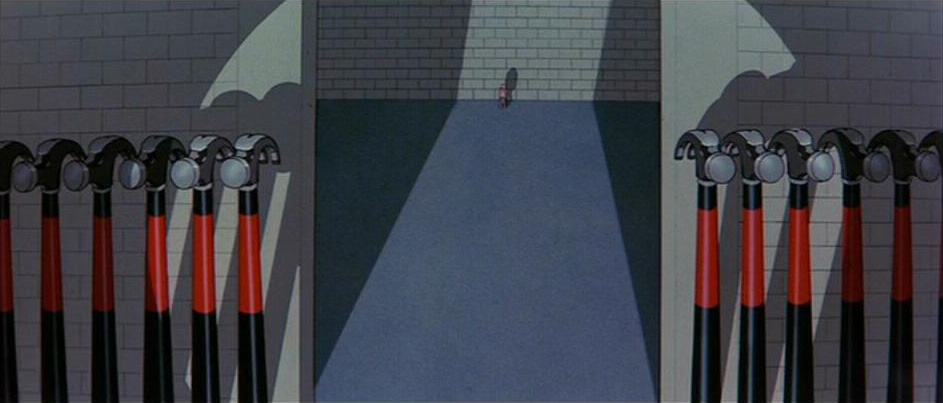
In his 1979 summary of the album, Roger Waters described the song as Pink putting himself on trial. He continued by saying that “the judge is part of him just as much as all the other characters and things he remembers. They’re all in his mind, they’re all memories.” Being figments of his imagination, each character, though somewhat independent of Pink’s main persona, are influenced by his ideas and memories. For example, the character of his mother is more a representation of how Pink views his mom rather than an actual depiction of how she is in real life – a key point that has been reinforced ever since her introduction in “the Thin Ice.” It must be remembered that it is Pink and Pink alone who is on trial here, not the bricks that have populated his life. And in keeping with the Floydian irony that is so much a hallmark of the album, while most trials determine whether a person goes to jail or not, Pink’s trial will determine whether he will be freed from his self-created prison cell.
Even before the prosecutor begins to make his case, the listener is acutely aware of the dramatic shift into the topsy-turvy world of Pink’s mind, thanks to the highly stylized opening music. Orchestral instruments have indeed played background roles throughout album, but in “the Trial” they dominate, easily comprising over half the score of the song. The result is a theatrical, almost circus-like intro that immediately throws the listener off balance – not unlike what Pink himself is experiencing.
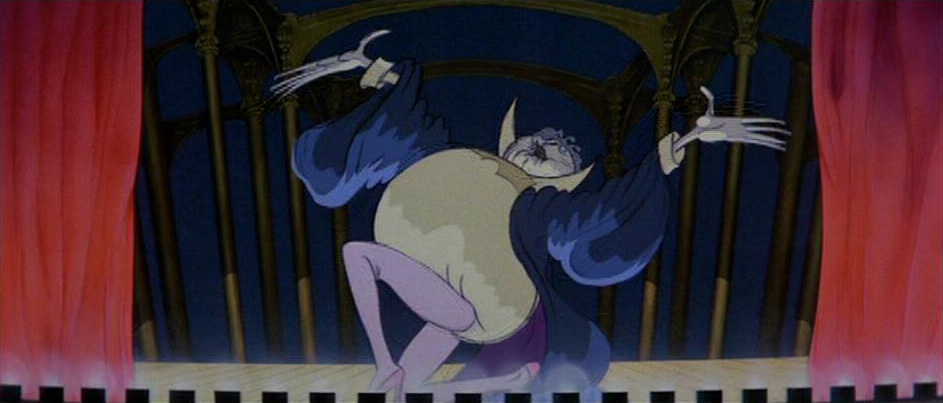
In his opening remarks, the prosecutor addresses the Judge as “Worm your honor,” a title that recalls that well-used symbol of decay found throughout the second half of the album. Couple this with the lawyer proclaiming to speak on behalf of “the crown” and one can easily imagine Waters poking fun at the British judicial system, insinuating that those who govern the lives of everyday citizens are little more than fops and closed-minded fools. In terms of the narrative, however, the title “Worm” also suggests that the lawyer and the judge (and jury, for that matter) – those characters who aren’t based on the memories of actual people – are entirely products of decay, birthed, as it were, from Pink’s wall. And so having been created out of this delirious isolation, it is only approporiate that the highest authority figure in Pink’s delusion – the Judge – is addressed as “Worm,” the all-encompassing symbol of decay. Consequently, as negative creations of the wall – that great metaphor of isolation and emotional repression – it is only natural that the charges leveled against Pink – that he has experienced “feelings of an almost human nature” – would be considered a high crime tantamount to treason. In this sense, both the lawyer and judge are like outgrowths of the same personal decay that spawned Fascist Pink. Like that most dark persona, they are equally vindictive and militant when it comes to stifling Pink’s true self, only springing to action when their very existence is threatened by the sudden epiphany of self-accountability in “Stop.” The irony of the ensuring trial and the recriminations against him is that, for the creatures of the wall, Pink’s selfishness throughout his life proves that his moment of “feelings” was a singular albeit punishable error; as Pink has come to realize, however, the offense isn’t in a single moment of humanity, but rather an adult lifetime devoid of it.
With the allegations made, the prosecutor calls the schoolmaster to the stand, who in turn wastes no time in lambasting Pink’s boyhood character. While his testimony about not being able to mold and control Pink as a child may find sympathy with the insular inhabitants of the wall, it’s affect on the listener is the very opposite, reminding us of Pink’s former idealism and individuality, of his childhood unwillingness (at least in mind) to conform to the strictures of an unjust system. And yet with this image of a young, fairly innocent Pink in mind, the wording of the schoolmaster’s attestations, with its reliance on the violent submission of “flay[ing]” and “hammer[ing],” also conjure up the oppressive, schoolmaster-like Fascist Pink molding his audience into the unquestioning cogs of his violent machinery. Both the listener and possibly Pink himself glimpse in this singular testimony the sheer breadth of Pink’s fall from grace, from the individualistic youth to a hyper-aggressive dictator much like the schoolmaster himself (or rather, Pink’s version of the schoolmaster).
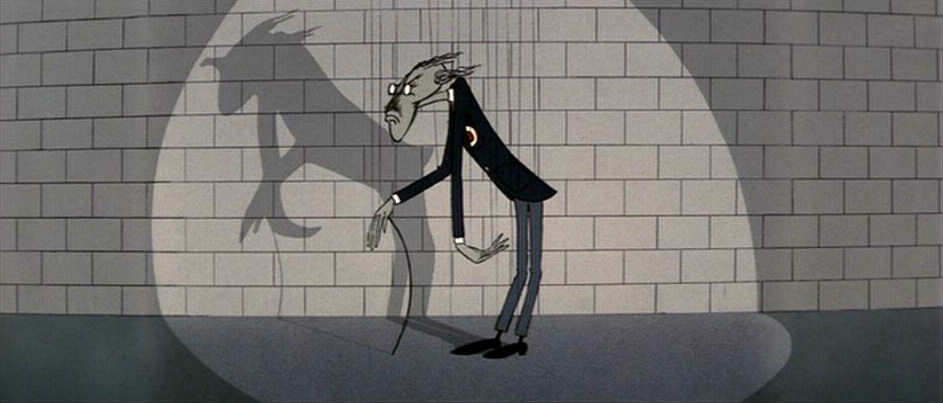
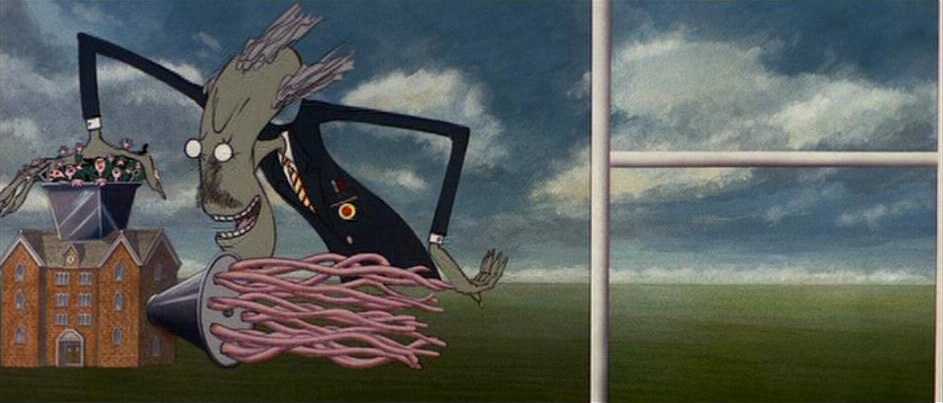
Spurred by both the accusations, Pink’s true self finds voice, pronouncing that he’s “crazy, toys in the attic. I am crazy. Truly gone fishing. They must have taken my marbles away.” Each of the lines has at some point in time been a popular euphemism for varying degrees of insanity. The gist of each is that mentally, there’s “nobody home.” What makes these euphemisms particularly interesting is that they all have a certain childlike connotation, from toys to fishing to marbles, as if the schoolmaster’s rant really highlighted for Pink the depths to which he’s descended from his former childhood innocence. One might also suggest that the childhood imagery suggested by these euphemisms might also serve as a sort of roundabout realization of just how long he’s been building his wall – since the days of toys and marbles.
After a choir of wall creatures echos Pink’s sentiment, though with a mocking lilt, the wife glides onto the witness stand and delivers a linguistic thrashing that Pink truly deserves. While the teacher and mother’s testimonies are actually thinly veiled laments on their loss of control over Pink, the wife’s accusations are spoken more from a valid base of personal betrayal than the conceited complaints of the other two witnesses. Getting directly to the point, she accuses him of not “talk[ing] to me more often” and of going “your own way,” both of which contributed to the lack of communication and personal schism that ultimately destroyed their relationship. In a snide remark referencing Pink’s accountability in their failed marriage, the wife sarcastically asks if he’s “broken any homes up lately,” beforeasking the judge, much like the teacher, for “five minutes…alone” with Pink to exact retribution. Although one would expect such an attack rom a slighted lover, one must again remember that this is not the wife testifying, but rather Pink’s internal representation of her. This is Pink testifying against himself, and for the first time in the entire album, he is seeing his broken marriage from his wife’s perspective, realizing that he shoulders a great deal of blame for the dissolution of his marriage. Until now, he has solely blamed his wife for her infidelity, wondering how she “could…treat me this way,” never quite grasping that her actions had been entirely contingent upon his neglect. But in her testimony in “the Trial,” Pink finally understands how his wall – his self-absorption and lack of emotion – contributed to her unfaithfulness, proving to himself that he has, indeed, been “guilty all this time.”
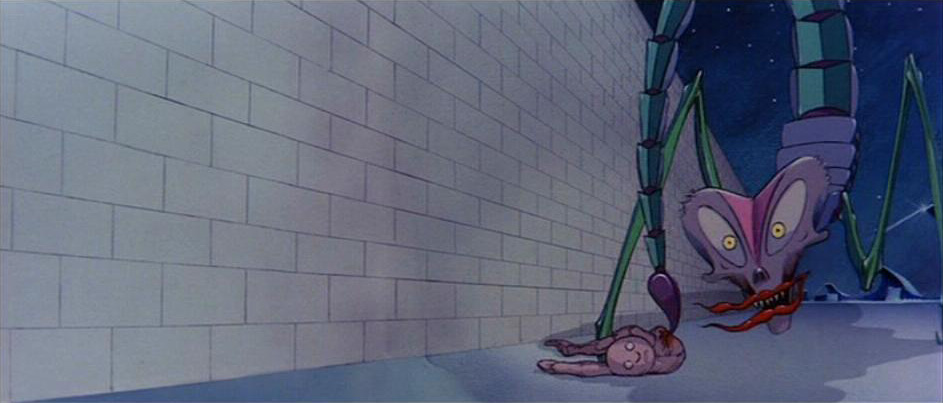
Whereas the schoolmaster’s testimony presented a spectrum for Pink’s descent, contrasting the innocent idealist with the schoolmaster-like fascist he becomes; and the wife’s allegations hinted at a protagonist finally coming to terms with marital accountability; the testimony of the third and final witness – Pink’s mother – proves to be a bit more problematic. For starters, the most damning thing she accuses her son of is leaving her, something that all children must do eventually. Her wall-like protectiveness as portrayed in songs like “Mother” is no less diminished here, with Pink’s representation of his mother singing “Come to mother baby, let me hold you in my arms…I never wanted him to get in any trouble…Worm, your honor, let me take him home.” While it can be said that Pink realized important things about himself through the testimony of the schoolmaster and wife, it’s hard to say whether there is any great lesson learned through the Mother, apart from the seeming fact that some bricks are unavoidable. Some might argue that Pink’s brick was a result of his overreaction to her rather understandable maternal protection, in which case her appearance in this song causes him to realize that he’s pushed her away for something as petty as simply loving him too much (at least by his estimation). It very well could be that he only now realizes that the brick he fashioned in his mother’s appearance was wildly exaggerated, mistaking parental concern heightened by the loss of her husband with Orwellian scrutiny.
Pink once again sings of his insanity, this time relying on euphemisms that reflect the loss of any sense of reality (“over the rainbow,” much like Dorothy entering the fantastical Oz) as well as his self-induced imprisonment (“bars in the windows”). The purpose of Pink’s self-professed craziness is a bit uncertain. Some might claim that he is entering a plea of insanity into the trial record, and thus attempting to distance himself from his actions. Considering that the song is largely about revelation, though, it seems more likely that his various euphemisms for “crazy” are a reaction to the consequences of his isolation, an admittance that his psychological descent was due to the very bricks he now knows he willingly constructed. Such dawning comprehension leads him to correctly conclude that “there must have been a door there in the wall when I came in.” Pink was so convinced that the only way to deal with an injurious world was to build an emotional wall that he became completely blind to the exit provided by simple personal and social connection, an abandoning of the self-indulgent notion that “I don’t need no arms around me” and a true embracing of the idea that “together we stand, divided we fall.”
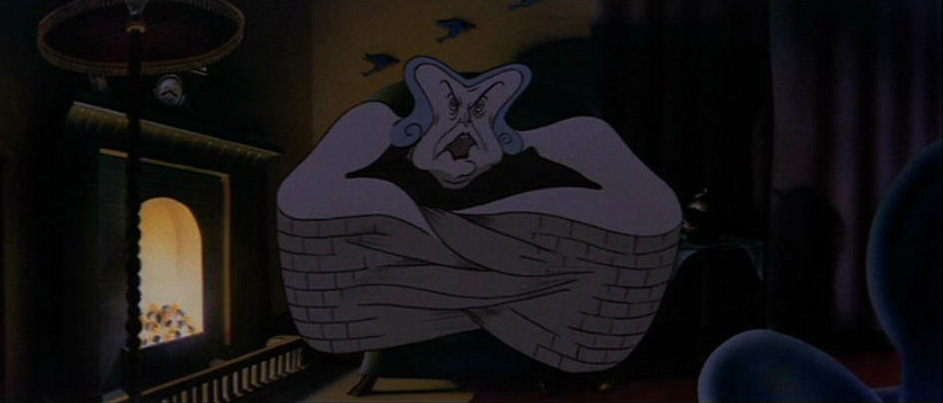
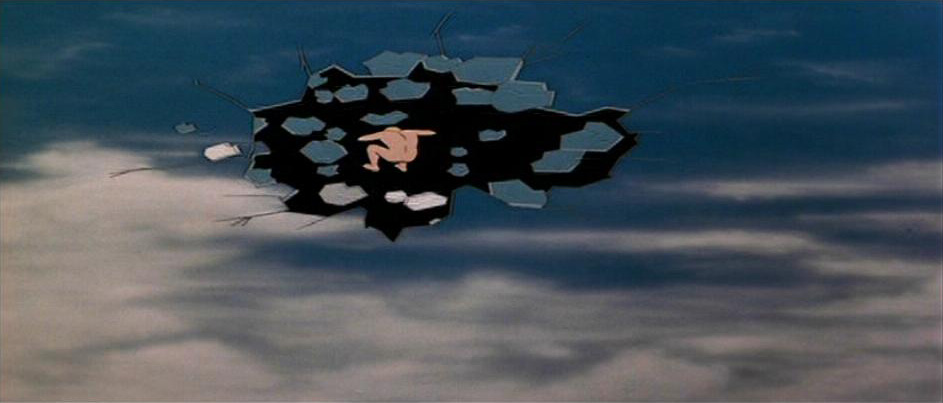
The Judge finally thunders into the song after Pink’s pronouncement, accompanied by the familiar three-note Wall theme that threads its way throughout the album, connecting all the bricks of Pink’s wall like cement. In what is perhaps another slight against the British judicial system, the judge proceeds with his verdict without allowing the jury time for deliberation. Despite the fact that the Judge has more lines in the song than any one character, both he and his verdict still remain a bit of a mystery for many Floyd fans. If the trial is a result of Pink showing “feelings of an almost human nature,” wouldn’t the judge reward rather than punish Pink for making his “exquisite wife and mother” suffer? That is, shouldn’t the Judge – a product of the wall – praise Pink for not showing emotion towards these two central figures in his life? Likewise, isn’t his verdict to “expose yourself before your peers” by tearing down the wall counterintuitive for a delusional persona whose very existence is based on self-isolation and mental decay?
All valid points. There are those who’d say that the Judge is the Wall’s deus ex machina or “god out of the machine” – an unexpected and perplexing figure or event in a story that brings about the sudden resolution of a problem; that is, Waters’ quick-fix resolution to concluding Pink’s story. While deus ex machina have a long and storied literary tradition, the very randomness of their nature as plot-solving devices can make them feel contrived and contradictory to the overall narrative. Case in point, the Judge, who appears in the story out of nowhere, delivering the exact resolution that is needed to conclude Pink’s story.
An alternative perspective is that the Judge is the perfect vehicle for Pink’s epiphany, inconsistencies and all. This analysis has mentioned previously how the Wall can be read as a metaphor for Carl Jung’s concept on individuation, the process by which the fragmentary bits of persona coalesce into a self-actualized whole…or in plain English, the psychological process by which a person becomes his or her true self. For Jung, this was impossible to achieve without a reconciliation of one’s lighter and darker halves. To borrow from religion, a person is just as much Satan as he or she is Jesus, equally capable of good as much as evil. By this interpretation, the Judge would be the psychic manifestation of Pink’s lighter and darker halves, an epitome of all of the fractured personas – good and bad. This is why the Judge seems to contradict himself and his own motives, often within the space of back-to-back lyrics. The darker half concedes to punish Pink to the “full penalty of law” based on the lawyer’s accusations that Pink has briefly shown “feelings of an almost human nature” (that blip of sanity in “Stop” amidst his fascist insanity), while the other half seems to sympathize with the “exquisite wife and mother”, accusing Pink for making them suffer…something a truly unfeeling, unemotional wall creature wouldn’t care about. [Those familiar with Jung’s writings will no doubt recognize the concept of the anima in Pink’s representations of the wife and mother.] The darker half wants to punish Pink, ironically, by having him tear down his wall and cut himself off from the society of wall creatures he’s created in his mind; the lighter half equally wants to tear down the wall, though as reward for Pink finally “revealing all his deepest fears” to himself. Thus, Pink’s epiphany is equal parts light (the childhood self that yearned for creative independence) and what Jung termed “the shadow” (his fascist persona that was little removed from the very zeitgeist that killed his father), with the Judge mediating between the two as the very voice of Pink’s conscience. Correspondingly, the crowd’s chants of “tear down the wall” can be interpreted as both vindictive petition for punishment by the wall personas or the concerned pleas for Pink’s well being voiced by those “bleeding hearts and artists” outside the wall. Ultimately, his light and dark selves meet, resulting in the destruction of the defenses that have isolated him from both society as well as his true, whole self.
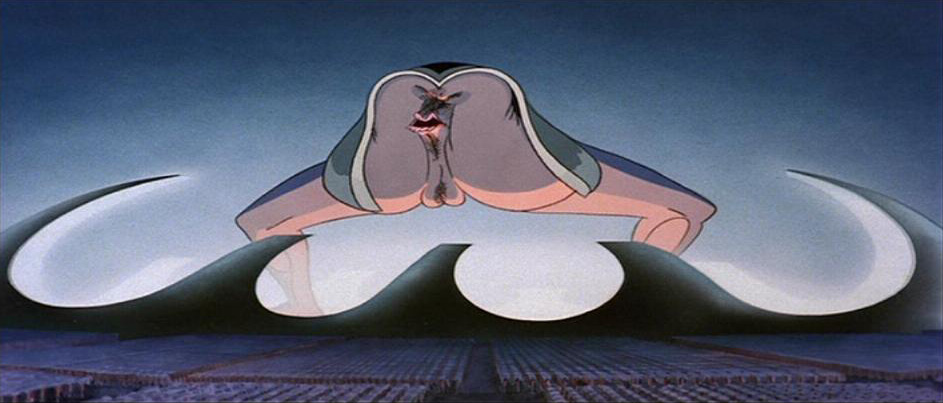
Whether judgment as deus ex machina or as the embodiment of Pink’s psychological revelation, the wall comes down. As with nearly every facet of this monumental album, there’s a bit of debate as to what this symbolic event actually means for Pink in the real world. Those who view the Wall as a more cynical piece tend to read the wall’s total collapse in negative terms, claiming that without any defenses whatsoever between himself and the injurious world, Pink is bound to spiral even further into insanity. Some even see hints of suicide or suicidal contemplation in the narrative’s climax, finding similarities between the end of “the Trial” and the lyrics of the title song from Pink Floyd’s follow-up album the Final Cut. In the song, the very Pink-like narrator – who “had a big hallucination” and refers to his own defenses as a “wall” (at least on the lyric sheet…the actual word “wall” is cut short when sung) – contemplates opening himself up to what the listener can only assume is his wife, singing “If I show you my dark side will you still hold me tonight? / And if I open my heart to you, show you my weak side, what would you do?” The narrator can only imagine such actions having negative consequences, such as the wife “sell[ing] your story to Rolling Stone…tak[ing] the children away, and leav[ing] me alone…will you send me packing? Or will you take me home?” The song culminates with lyrics that sound as if they were taken straight from the Wall’s narrative – “Thought I ought to bear my naked feelings. Thought I ought to tear the curatin down” – before the narrator nearly kills himself, recalling “I held the blade in trembling hands, prepared to make it…but…just then the phone rang. I never had the nerve to make the final cut.” Since some of the songs from the Final Cut are said to be leftovers from the original Wall demo sessions, some fans cite “the Final Cut” song as proof that, when Pink “tear[s] the curtain down,” he can’t bear the instant exposure, and so attempts suicide.
As compelling an argument as that may be, the majority of fans aren’t content to leave the Wall on such a pessimistic note. For them, the wall’s destruction amounts to nothing short of Pink’s redemption; and indeed, in his 1979 summary of the album, Roger Waters stated that Pink’s “judgment to de-isolate himself…is a very good thing.” Perhaps for the first time in his life, Pink is unfettered by past burdens and is able to experience life to the fullest without the hindrance of dulling mental defenses. While Pink was born into the world in “In the Flesh?” and continually born into new incarnations throughout the album, the destruction of his wall marks his true rebirth of self. Though he is now more vulnerable to the pains of life, he is also more opene to life’s pleasures, allowing him to truly connect with his emotions, his loved ones, and the world. As Pink’s story attests, the wall-like defense mechanisms are in reality more oppressive than protective, replacing humility and understanding with egotism and decay. And though the world remains imperfect despite one man’s enlightening journey, the destruction of this one wall removes yet another brick from the larger wall of humanity. The destruction of this one wall becomes another broken link in the vicious, circular chain of oppression and violence. With enough bricks and links gone, the social wall of prejudice will collapse and the circuitous cycle of injustice will be broken.
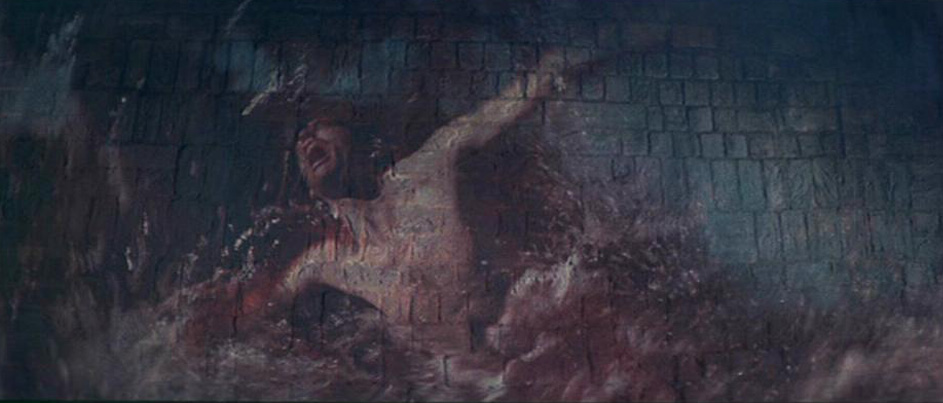
Rivaling the complexity and beauty of “Goodbye Blue Sky” and “What Shall We Do Now,” the animation sequence for the “the Trial” is every bit as resplendent as the song’s music and lyrics. The scene opens to reveal Pink, now in the form of a faceless rag doll, sitting against his wall, awaiting the commencement of his trial. Even from the beginning of the sequence, one wonders why Pink is depicted as a harmless, relatively motionless doll in this, his most decisive moment. One theory holds that once he starts this process of self-judgment, he is unable to stop it. In other words, he is at the mercy of reliving and realizing his bricks. Others maintain that this is merely a reflection of how he’s viewed himself his entire life, as the immobile plaything of the world’s ills, a victim tossed about from one injurious incident to another. Although “the Trial” is largely about him overcoming this presumptuous perspective, he still does not break free from the grasp of his burdens until the end of the song when his wall is torn down. In a way, he still is the plaything of his bricks until he destroys them. He has been created and shaped by the people in his life and the feelings he represses and so he is continually acted upon by these very factors until he finally acts. As we’ll see later in the sequence, he still is tossed around by his memories / bricks up until the time of the wall’s destruction.
The ensuing trial is depicted as a showy theatrical number much like it is on the album. The courtroom, complete with stage lights, is more of an arena than a house of law, just as the prosecutor is more like an actor than a lawyer, putting on makeup and dancing around the stage. Once again, the social implications are fairly blatant, equating the judicial system with public spectacle (mob spectacle, perhaps) rather than a means of justice. Accordingly, the worms of decay slither into the arena and form the judge’s stand, the “Worm, your Honor” himself represented as a giant, serpentine wig in the beginning.
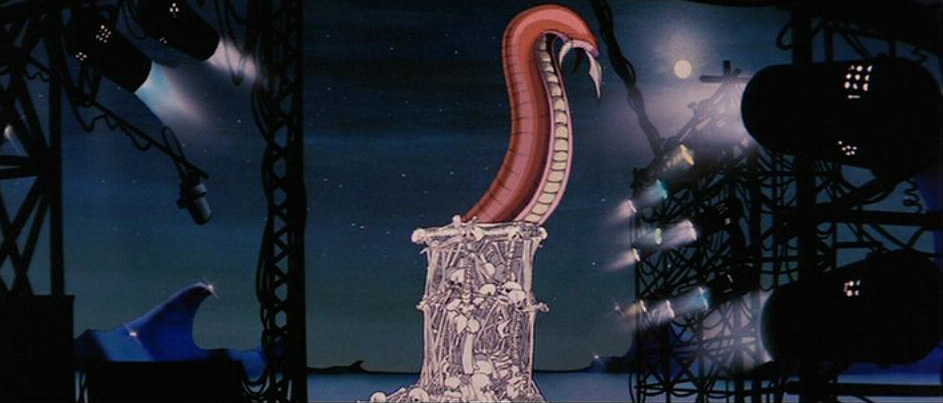
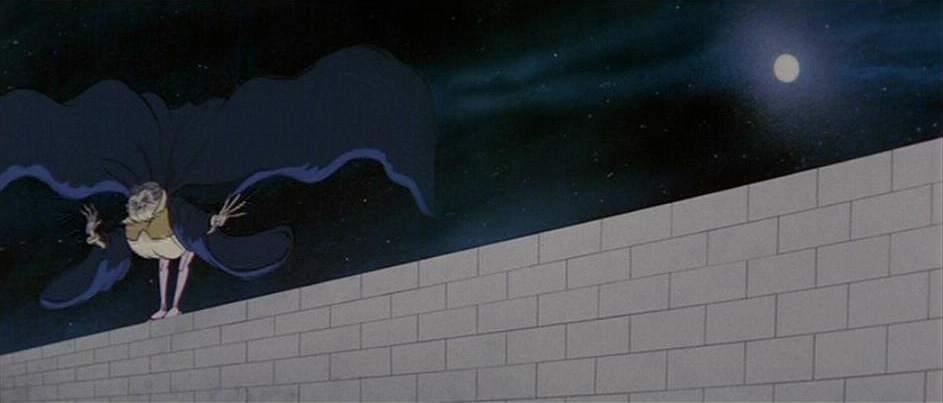
The schoolmaster delivers his testimony dangling as a marionette from the strings controlled by his “fat and psychopathic wife,” instantly recalling that vicious cycle of oppression first detailed in “the Happiest Days of Our Lives.” As mentioned before, though one is inclined to see Pink as the blameless victim of this particular brick – what with the teacher beating a Pink puppet with his cane and feeding a riggling mass of faceless students into a meat grinder – having just come off a seires of songs in which Pink acted in much the same way, molding his fans into faceless minions, the audience is reminded firsthand just how far-reaching that cycle of abuse can turn. That the schoolmaster turns into a hammer at the end of the song, a symbol that is largely associated with Pink and his fascist rule throughout the album’s second half only hammers home this idea that in submitting to his wall, Pink has turned into the very force of tyrannical cruelty against which he once rebelled.
Tossed around by the forces of his bricks, a leaf-turned-faceless-man-turned-back-to-leaf drifts into the darkness of his own psyche. Whereas Pink once thought of himself as blown about by the ills of the world, it would seem he realizes that he is thrown about by his own wall, futilely caught like a leaf in its gusts.
His wife slithers from under the wall, turning into a scorpion creature reminiscent of Pink’s hallucination in “Don’t Leave Me Now.” She stabs the motionless doll before morphing into a distorted symbol of grotesque femininity, an amalgamation of breasts, legs, and vagina. Though Pink comes to realize his accountability in their failed marriage, he still portrays his wife in the same negative way he does the other witnesses. After all, this is the brick that she created out of her infidelity. No matter how guilty Pink is concerning their failed relationship, her subsequent actions still created an emotional wound within Pink’s mind, a wound which in turn became this particular brick of whorish womanhood. Building on this male chauvinist idea of womanliness (yet another part of Pink’s shadow), the mother bursts from the wall as a fighter plane (concurrently representing the father’s war-related death) prior to changing into a giant, vaginal mouth that grabs Pink with an umbilical cord and pulls him back into the mother’s arms where she thinks he belongs. For the darker, repressed side of Pink, women are either injurious through their immorality or oppressive through their neurotic guardianship. Correspondingly, both ideas of womanhood add to Pink’s bricks, just as the mother herself turns into a wall, enclosing Pink within.
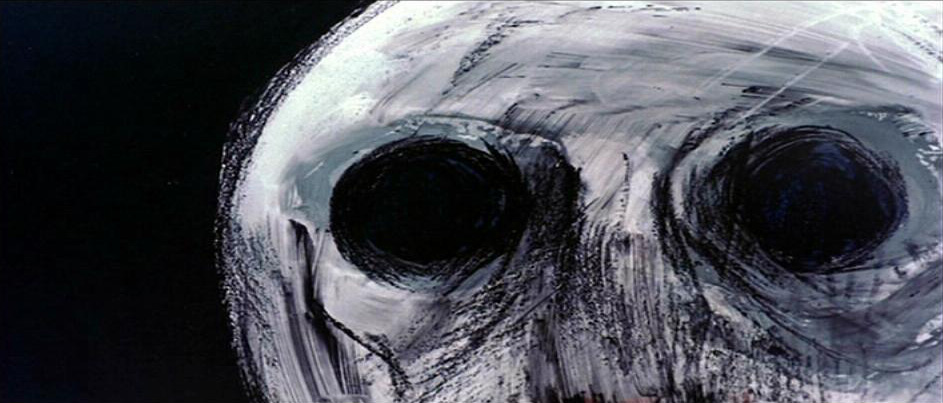
As Pink sings of his lunacy a second time, a faceless man falls through the sky, breaking it into innumerable shards and revealing the blackness underneath. The thematic imagery is similar to that of “Goodbye Blue Sky” in which the limitless dreams of youth are broken, exposing the hollowness of adult life. The image is also redolent of Jung’s theory of individuation, with the tumbling Pink straddling the realms between his light side (the sky) and his shadow (the darkness underneath).
From a symbol of decay to one of judicial incompetence, the worm Judge turns into what art director Gerald Scarfe succinctly calls “a giant asshole,” representing what “many people think about the law” (The Wall DVD commentary). He is simultaneously imposing and comic, roaring his verdict like thunder while also literally talking out of his ass. Considering that “the Trial,” for all its frivolity, is a highly significant turning point in Pink’s life, it might seem odd to portray the judge as such a dichotomous character, one who is both serious and farcical. However, this duality speaks volumes about the absurdity of both personal and societal isolation. While the creation of the wall and Pink’s subsequent journey towards self-discovery and individuation is a weighty topic, the very reality that one can become so self-absorbed and intentionally detached from the world is equally absurd. Simply put, to think that life revolves completely around one’s self is as ridiculous as the thought of a giant talking ass.
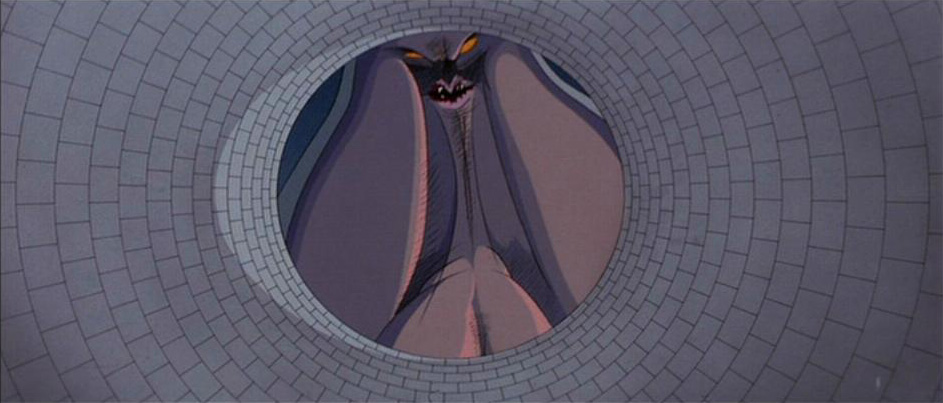
After his wall encloses him when the verdict is announced, images from Pink’s life (ie, visualizations of his bricks) flash onscreen as the crowd repeatedly chants “tear down the wall.” He is reliving each moment that has led him to his current state: his fascist persona, his marriage, the wife’s adultery, the teacher molding the schoolchildren into Ideal Citizens, the hammers, the hate rally, the wartime implications of the German war eagle, the groupie, the rat, the doctor injecting drugs into his arm. Each image is a mere flash in a seemingly endless barrage of injuries, all of which fade to reveal Pink’s enormous wall spanning the entire screen. After a prolonged silence, the bricks explode with Pink’s screams, the screen eventually obscured by clouds of white dust. Although one could argue that this dust, similar to the white fog into which the soldiers march in “the Thin Ice,” symbolizes Pink’s death at the collapse of his massive creation, the fact that it fades into to the children in “Outside the Wall” could just as readily implicate that the white dust is Pink’s enlightenment and the purity regained through the destruction of the wall. After a life filled with oppression and corruption, Pink has finally been reborn whole, complete.
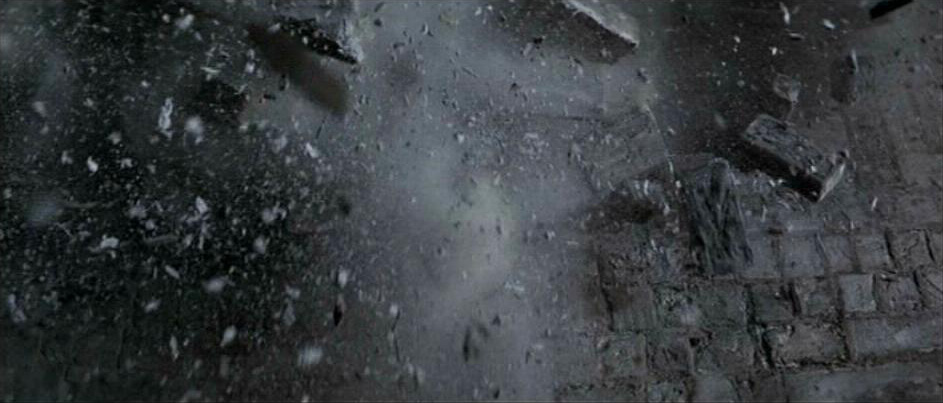
What Other Floydians Have Said
"The Judge in 'The Trial' (Pink's conscience) condemns Pink for selfishness and hurting people who loved him, and then sentences him to be exposed, which is what the album is: an exposure of Pink's narcissism. So, at the beginning of the album you are listening to the Judge's sentence: exposing Pink before his peers." - Chris Wilson
"Wouldn't you think that it is totally reasonable to believe that the Rag doll representation of Pink during 'the Trial' could very well be due to the wall people associated with the song in general? You stated that the schoolmaster and mother figures are both playing upon the idea of the innocence and individuality of Pink's childhood. Also with the addition of the lyrics 'Toys in the attic' and all the rest of Pink's actual dialogue revolves around a very child-oriented basis. The rag-doll representation could simply be an extension of Pink longing for his lost childhood. The same with viewing the school master as a marionette. Both can be associated with youth. Also the representation of the wife could be reminiscent of his childood. Children would probably associate scorpions with something they would be afraid of, and this is fitting because her testimony is by far the most damaging of the three." - Shane
Author's Addendum: Interpreting the doll as a symbol of Pink's stunted childhood also provides a ready explanation for the clips of the large rag doll entangled in barbed wire...Pink's innocence is perpetually tied up with the death of his father on the battlefield.
"When Pink's Mother asks to take him home she cuddles him in arms made of bricks. This shows that often people can entrap others within their own walls, and can thus become bricks of each others wall. It's ironic that his mother is trying to trap him in her own protective wall, when this is what he is being tried for. Also this leads me to think that the wall symbol goes much further than self entrappment; say for example, love. We always know love as sharing and being together, but maybe love is just two people sharing the same wall. And hate could be when teh walls of two people clash." - Verdi
"After watching Pink Floyd: The Wall for about the billionth time, something struck me: You don't see any male reproductive parts in the movie until the judge makes his grand appearence on his stage. An explanation for this soon followed: Remember, Pink's mother corrupted his thinking. I think she corrupted the way he views women, so he views them as cheap toys or playthings, as seen in 'Young Lust.' Therefore, he sees no sacred value in their reproductive parts, and you can see this through the rampant female nudity throughout the film. Therefore, his view of the male organ is lifted into a more valued, sacred level, and is not seen until someone honorable (or in this case, simply powerful) is brought out, i.e. the judge." - Matt Schwager
Author's Addedum: Matt raises an interesting point that not only applies to the Wall (both film and movie), but to so much of the world's art, literature and music. One can easily say that Pink's internal representations of women are a result of his upbringing, but is this an intentional satirization of a largely patriarchal society's categorization of women, or an unintentional dissemination of it? Even in today's modern art and public life, women are often pigeonholed into two broad, stereotypical categories: the virgin and the whore - that is, the naively inexperienced or the vulgarly over-experienced. In movies, this can be found everywhere from the hooker with the heart of gold to the innocent waif who is always in need of saving by the strong leading man. Such stereotypes in the arts even carry over to public life, in which a strong yet stubbornly opinionated man is deemed a "leader" while an equally strong, opinionated woamn is deemed "ruthless," "conniving," or simply a "bitch." Correspondingly, all the women in the Wall are either sexual playthings (the groupie, the wife) or sacrificing, virginal martyrs (the mother). As mentioned above, the fact that there are no deeply developed women in either the album or movie can either be attributed to what may be Roger Waters' and the bands' own inherent mysoginism or, rather, an entirely intentional and satrical look at the absurd puritanism that still inhabits purportedly progressive Western thought.

